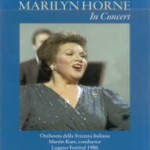Throughout the 1960s, ’70s, and ’80s Marilyn Horne was the greatest bel canto mezzo-soprano in the world, a position that, despite the rise of great singers like Cecilia Bartoli and Jennifer Larmore, no one ever attempted to dispute. Today, any coloratura mezzo coming along is still compared to her. She retired from the concert stage in 1999 and now occasionally sings in pops concerts; by the early and mid ’90s her glory days were over, but she maintained her tonal center and breath control. The voice coloration–for the five people on earth who have never heard her–was dark and chocolatey; her accuracy in coloratura was outshone only by her impeccable diction, absolute accuracy of pitch throughout an almost three-octave range (her top note was a C), infallible musicianship, attention to text, and sincerity of utterance. She was one of the few “perfect” singers who was never boring.
This recital, taped in Lugano, Switzerland in 1986, arguably finds her at the end of her prime (she had a prime that lasted even longer than that of her frequent partner in song, Joan Sutherland), but newcomers would be hard-pressed to notice anything wrong –and so am I. Comparing her versions of these arias to her own of 10 years before might reveal fuller high B-flats and Bs, but otherwise in this recital she could still pass for the world’s greatest mezzo. The seamless legato of Orfeo’s “Che puro ciel”, the wild, spotless fiorature of “Ti tanti palpiti” and “Cruda sorte”, the lovely pianissimos of Delilah’s second-act aria, the naughty attitude she presents for Urbain’s aria from Les Huguenots, the head-spinning allure of Rossini’s infrequently heard Canzonetta spagnuola, the booming low notes that punctuate the end of several arias, the perfectly-in-place grace notes in the allegro to “Cruda sorte”, the trill that always “catches”, and the sass she brings to Carmen’s “Habanera” may never be equaled.
Martin Katz conducts like the combination fine musician and accompanist that he is, and the Swiss Orchestra plays handsomely. The orchestra’s solo contributions–dance sequences from Gluck’s Orfeo, overtures to Cherubini’s Anacreon, Thomas’ Mignon and L’Italiana–are splendid. The sound–good, solid stereo–and picture are excellent. Subtitles are provided in English, German, French, Italian, and Spanish. A lengthy interview, audio only, from 2004 in Cardiff, is included. If you think you have a favorite bel canto mezzo other than Horne at the moment, it’s time to visit her again through this DVD and see how you feel. [6/8/2007]
































